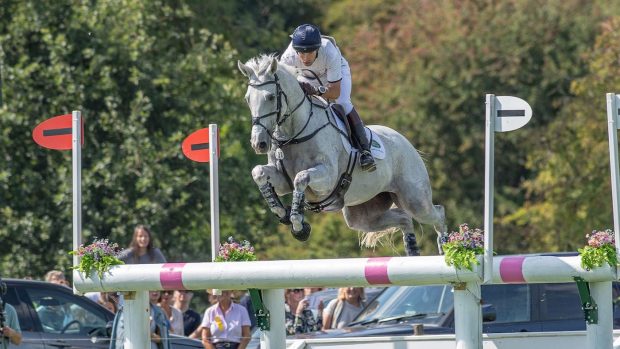During high-speed exercise, one of the common problems affecting breathing, and therefore performance, is a malfunction of the soft palate called DDSP (dorsal displacement of the soft palate). This is commonly referred to as “choking up”, “gurgling”, or “swallowing the tongue”.
It is caused by the soft palate temporarily becoming dislodged from its normal position and dramatically reducing the airflow in and out of the lungs. This is commonly accompanied by a sudden onset of a gurgling-type noise and poor performance. Despite extensive research the cause of DDSP remains a mystery.
Endoscopic examination of the horse at rest cannot provide a diagnosis of DDSP because it is a functional problem occurring only when under the pressure of hard exercise. Nevertheless, a resting examination will provide useful information about whether there is a primary physical problem that might make the palate unstable.
Examples of primary problems might be a cyst within the palate itself or in the tissues beneath the epiglottis, an ulcer on the edge of the palate or excessive inflammation within the throat. In these cases, treatment for the DDSP will not be successful until the primary problem is sorted out.
In the past 10 years, the development of high-speed treadmill endoscopy has proved a very useful tool in investigation of DDSP. Horses are trained to exercise on a treadmill and an endoscope is placed via the nostril and attached to the noseband so that images are viewed of exactly what is happening in the airway when the problem occurs. Treatment can be given that is specific to those findings.
The palate actually displacing can be the result of a complex series of events and each horse may displace its palate as a result of a slightly different set of circumstances.
There are several theories on the possible causes of DDSP and the variety of treatment options used by different surgeons reflects this. Possible
hypothesized causes include:
- Open-mouth breathing, leading to the soft palate billowing up and making the seal with the epiglottis liable to break
- The tongue being pulled backwards, leading to lifting of the soft palate and breaking the seal
- Increased negative pressure in the airway, possibly secondary to lung disease
- A small or flaccid epiglottis, weakening its ability to keep the soft palate tucked underneath it
- An inherently incomplete seal between the palate or epiglottis
- The strong ventral neck muscles pulling the larynx back excessively, thus reducing the area of epiglottis in contact with the palate
- Excessive head flexion
- Lack of pharyngeal/throat tone associated with unfitness
Because of the difficulty in determining the cause of DDSP, it is not surprising that a variety of treatment options have evolved, many with only a moderate success rate.
The use of tongue ties and figure-of-eight nosebands to keep the tongue under the bit and prevent oral breathing are often tried and are sometimes helpful
In cases where there is a lot of inflammation in the throat region, medical treatment may be a solution. This can be carried out daily, by both oral and topical anti-inflammatory agents (with a flexible catheter passed via the nostril and up into the throat region).
In all cases, the horse’s level of fitness should be assessed and, if necessary, increased, before deciding on a surgical option. It is only once any medical issues have been addressed and there are no underlying primary reasons for the palate becoming displaced that the horse becomes a surgical candidate.
No one surgical option for DDSP has been entirely satisfactory and surgeons are still seeking an ideal solution to the problem. One of the earlier surgeries performed was cutting a strip off the back edge of the soft palate (staphylectomy). This is still a popular option with a relatively high success rate, but exactly how it improves stability of the palate is not clear.
It is thought that the scarring at the edge of the palate may stiffen it and produce a tighter seal, thus reducing the likelihood of DDSP. Also, if displacement were to occur, a shorter palate would obstruct the airway less and would be more easily returned to its normal position underneath the epiglottis.
In the early 1990s, a surgical procedure was developed to take a “tuck” in the palate from side to side, making the palate tighter and less likely to billow up and displace.
Some surgeons try to make the palate firmer and more stable by firing it in lines along its length. Another popular treatment is removing a section of the muscles (myectomy) on the underside of the neck that are responsible for pulling the larynx backwards, thus reducing the area of epiglottis in contact with the palate. This is often performed in combination with a staphylectomy.
In horses with a small or flaccid epiglottis, some surgeons felt that it was advantageous to increase its stiffness, thus enabling it to maintain its position above the palate more easily and preventing DDSP. This view led to an operation being developed where a Teflon paste was injected on the underside of the epiglottis. In some cases encouraging results were seen, but this procedure has been less commonly performed recently.
In America, a surgery has recently been developed that moves the larynx forward
(a laryngeal “tie-forward” operation). Large sutures, attached to a bone in front of the larynx, are tensioned to each side of the larynx, thus pulling it forwards. This means that the epiglottis is well hooked over the palate and at exercise the neck muscles are not able to pull the larynx backwards.
This surgery has been performed in more than 100 cases so far and early results look encouraging. Nonetheless, it is probable that some cases of DDSP will still be a perplexing problem for vets in the future.
|
||
 |
||


 Get up to 19 issues FREE
Get up to 19 issues FREE TO SUBSCRIBE
TO SUBSCRIBE 



